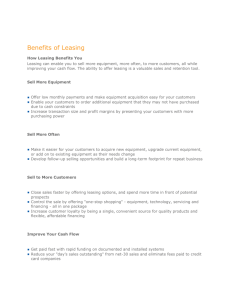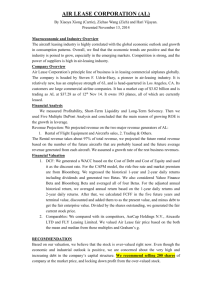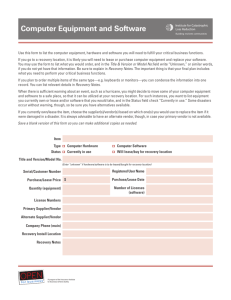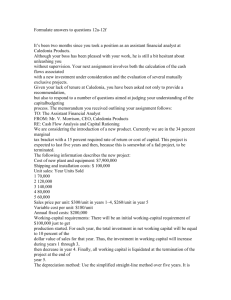Lease Referral Fees
advertisement
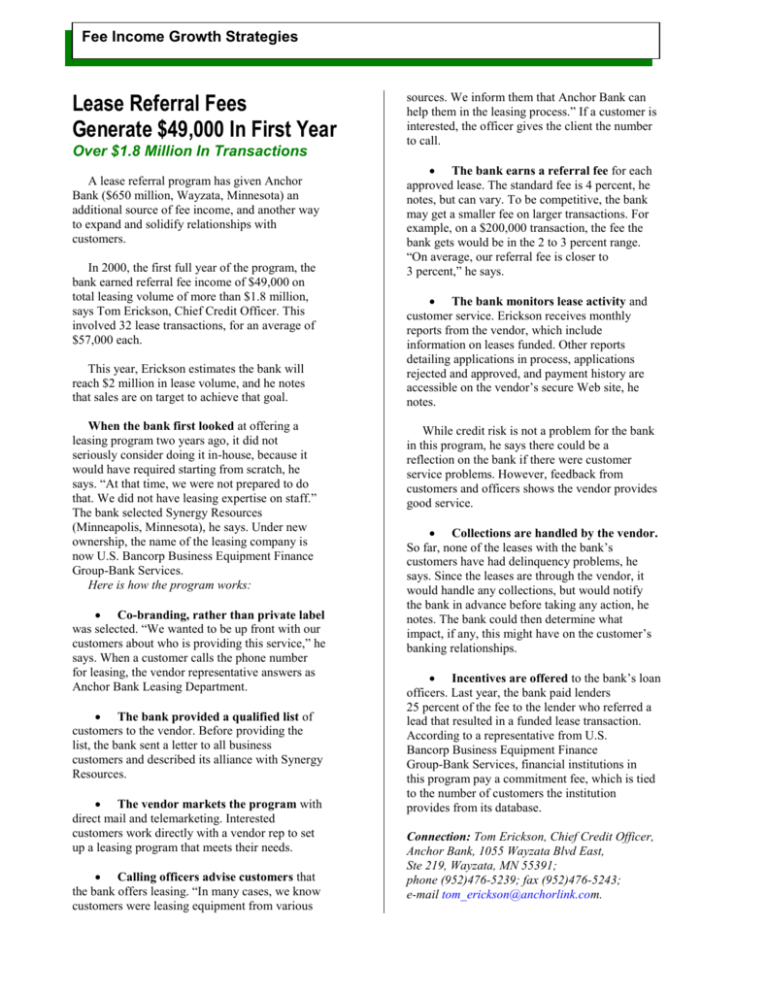
Fee Income Growth Strategies Lease Referral Fees Generate $49,000 In First Year Over $1.8 Million In Transactions A lease referral program has given Anchor Bank ($650 million, Wayzata, Minnesota) an additional source of fee income, and another way to expand and solidify relationships with customers. In 2000, the first full year of the program, the bank earned referral fee income of $49,000 on total leasing volume of more than $1.8 million, says Tom Erickson, Chief Credit Officer. This involved 32 lease transactions, for an average of $57,000 each. This year, Erickson estimates the bank will reach $2 million in lease volume, and he notes that sales are on target to achieve that goal. When the bank first looked at offering a leasing program two years ago, it did not seriously consider doing it in-house, because it would have required starting from scratch, he says. “At that time, we were not prepared to do that. We did not have leasing expertise on staff.” The bank selected Synergy Resources (Minneapolis, Minnesota), he says. Under new ownership, the name of the leasing company is now U.S. Bancorp Business Equipment Finance Group-Bank Services. Here is how the program works: Co-branding, rather than private label was selected. “We wanted to be up front with our customers about who is providing this service,” he says. When a customer calls the phone number for leasing, the vendor representative answers as Anchor Bank Leasing Department. The bank provided a qualified list of customers to the vendor. Before providing the list, the bank sent a letter to all business customers and described its alliance with Synergy Resources. The vendor markets the program with direct mail and telemarketing. Interested customers work directly with a vendor rep to set up a leasing program that meets their needs. Calling officers advise customers that the bank offers leasing. “In many cases, we know customers were leasing equipment from various sources. We inform them that Anchor Bank can help them in the leasing process.” If a customer is interested, the officer gives the client the number to call. The bank earns a referral fee for each approved lease. The standard fee is 4 percent, he notes, but can vary. To be competitive, the bank may get a smaller fee on larger transactions. For example, on a $200,000 transaction, the fee the bank gets would be in the 2 to 3 percent range. “On average, our referral fee is closer to 3 percent,” he says. The bank monitors lease activity and customer service. Erickson receives monthly reports from the vendor, which include information on leases funded. Other reports detailing applications in process, applications rejected and approved, and payment history are accessible on the vendor’s secure Web site, he notes. While credit risk is not a problem for the bank in this program, he says there could be a reflection on the bank if there were customer service problems. However, feedback from customers and officers shows the vendor provides good service. Collections are handled by the vendor. So far, none of the leases with the bank’s customers have had delinquency problems, he says. Since the leases are through the vendor, it would handle any collections, but would notify the bank in advance before taking any action, he notes. The bank could then determine what impact, if any, this might have on the customer’s banking relationships. Incentives are offered to the bank’s loan officers. Last year, the bank paid lenders 25 percent of the fee to the lender who referred a lead that resulted in a funded lease transaction. According to a representative from U.S. Bancorp Business Equipment Finance Group-Bank Services, financial institutions in this program pay a commitment fee, which is tied to the number of customers the institution provides from its database. Connection: Tom Erickson, Chief Credit Officer, Anchor Bank, 1055 Wayzata Blvd East, Ste 219, Wayzata, MN 55391; phone (952)476-5239; fax (952)476-5243; e-mail tom_erickson@anchorlink.com.

